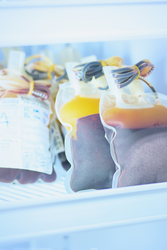Maximizing Efficiency and Performance: A Guide to Ultra-Low Temperature (ULT) Freezers
14th Feb 2024
Ultra-Low Temperature (ULT) freezers have become a cornerstone of scientific research labs across the globe. These workhorses store a wide range of biological samples, from enzymes and cell lines to tissues and DNA, at extremely cold temperatures, typically ranging from -80°C to -196°C. Given the valuable contents they house and the significant energy they consume, optimizing ULT freezer performance is crucial. This blog post will delve into strategies for maximizing the efficiency and effectiveness of your ULT freezers, ensuring the integrity of your samples and minimizing operational costs.
Temperature Management:
- Minimize temperature fluctuations: Frequent door openings are a major culprit for temperature spikes. Develop protocols to limit access and establish designated personnel for retrieving samples. Consider implementing alarm systems that notify personnel of open doors or temperature deviations.
- Temperature mapping: Regularly map the temperature variations within your ULT freezer. This helps identify hot and cold spots and allows for strategic sample placement. Manufacturers typically provide mapping services, or specialized companies can be engaged for this purpose.
- Proper sample storage: Avoid overloading shelves. Ensure adequate air circulation by spacing containers and vials strategically. Utilize freezer racks designed for ULT environments to optimize space and airflow.
- Consolidate and defrost strategically: Consolidate infrequently accessed samples into a single ULT freezer to reduce the number of units operating. Regularly defrost freezers according to the manufacturer's instructions to prevent ice buildup that can impede temperature control.
Inventory Management:
- Sample organization: Implement a robust sample labeling and organization system. This not only saves time during retrieval but also minimizes unnecessary door openings as researchers can locate samples efficiently.
- Inventory control: Maintain a detailed inventory of samples stored in the ULT freezer. Track sample age, location within the freezer, and expiration dates. Regularly review and purge expired or no-longer-needed samples to free up space and improve efficiency.
- Sample prioritization: Strategically place frequently accessed samples at an easily reachable height to minimize door opening time. Less frequently used samples can be stored higher or deeper within the freezer.
Maintenance and Service:
- Preventative maintenance: Schedule regular preventative maintenance by qualified technicians according to the manufacturer's recommendations. This proactive approach helps identify and address minor issues before they escalate into costly repairs or freezer failure.
- Gasket integrity: Regularly inspect door gaskets for wear and tear. Damaged gaskets compromise temperature control and can significantly increase energy consumption. Replace gaskets promptly when necessary.
- Vacuum integrity: For ULT freezers utilizing vacuum insulation technology, ensure the integrity of the vacuum seal. A compromised seal can significantly reduce energy efficiency and freezer performance. Consult the manufacturer's guidelines for proper maintenance procedures.
Additional Considerations:
- Monitoring systems: Utilize ULT freezer monitoring systems that provide real-time temperature data and alerts. These systems allow for remote monitoring and prompt intervention in case of temperature deviations.
- Energy-efficient models: When purchasing new ULT freezers, prioritize energy-efficient models. While the initial investment might be higher, the long-term energy savings can be substantial.
- Room temperature: Ideally, locate ULT freezers in a cool, well-ventilated area. Higher ambient temperatures can increase freezer energy consumption.
- Defrost water disposal: Establish a proper plan for defrost water disposal that adheres to environmental regulations and lab safety protocols.
By implementing these strategies, you can significantly improve the efficiency and performance of your ULT freezers. This translates to several benefits, including:
- Preservation of sample integrity: Consistent and optimal temperatures ensure the viability and functionality of your valuable biological samples.
- Reduced operating costs: Minimizing energy consumption through proper use and maintenance translates to significant cost savings over time.
- Enhanced lab safety: Proactive maintenance and monitoring mitigate the risk of freezer failure and potential sample loss.
- Improved lab workflow: Efficient ULT freezer usage optimizes sample retrieval times and streamlines lab processes.
In conclusion, ULT freezers are vital equipment for scientific research. By adopting best practices for temperature management, inventory control, maintenance, and strategic use, you can maximize the efficiency and performance of your ULT freezers.
Cenmed offers a wide variety of ultra-low freezers, refrigerators and other essential laboratory equipment. Contact us today to learn more about how we can help you achieve your healthcare supply chain goals.
(732) 447-1100 // info@cenmed.com

